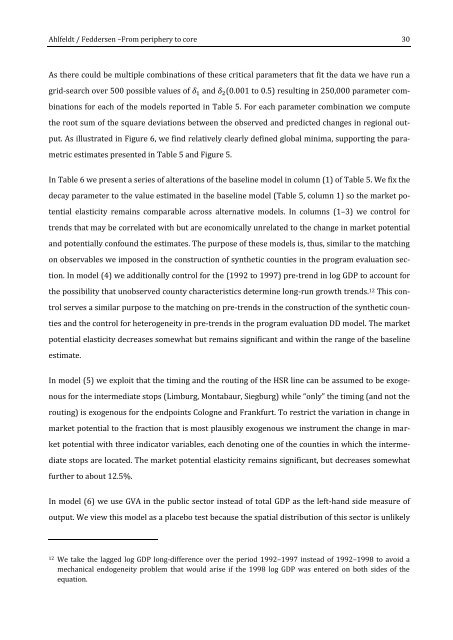sercdp0172
sercdp0172
sercdp0172
You also want an ePaper? Increase the reach of your titles
YUMPU automatically turns print PDFs into web optimized ePapers that Google loves.
Ahlfeldt / Feddersen –From periphery to core 30As there could be multiple combinations of these critical parameters that fit the data we have run agrid-search over 500 possible values of δ 1 and δ 2 (0.001 to 0.5) resulting in 250,000 parameter combinationsfor each of the models reported in Table 5. For each parameter combination we computethe root sum of the square deviations between the observed and predicted changes in regional output.As illustrated in Figure 6, we find relatively clearly defined global minima, supporting the parametricestimates presented in Table 5 and Figure 5.In Table 6 we present a series of alterations of the baseline model in column (1) of Table 5. We fix thedecay parameter to the value estimated in the baseline model (Table 5, column 1) so the market potentialelasticity remains comparable across alternative models. In columns (1–3) we control fortrends that may be correlated with but are economically unrelated to the change in market potentialand potentially confound the estimates. The purpose of these models is, thus, similar to the matchingon observables we imposed in the construction of synthetic counties in the program evaluation section.In model (4) we additionally control for the (1992 to 1997) pre-trend in log GDP to account forthe possibility that unobserved county characteristics determine long-run growth trends. 12 This controlserves a similar purpose to the matching on pre-trends in the construction of the synthetic countiesand the control for heterogeneity in pre-trends in the program evaluation DD model. The marketpotential elasticity decreases somewhat but remains significant and within the range of the baselineestimate.In model (5) we exploit that the timing and the routing of the HSR line can be assumed to be exogenousfor the intermediate stops (Limburg, Montabaur, Siegburg) while “only” the timing (and not therouting) is exogenous for the endpoints Cologne and Frankfurt. To restrict the variation in change inmarket potential to the fraction that is most plausibly exogenous we instrument the change in marketpotential with three indicator variables, each denoting one of the counties in which the intermediatestops are located. The market potential elasticity remains significant, but decreases somewhatfurther to about 12.5%.In model (6) we use GVA in the public sector instead of total GDP as the left-hand side measure ofoutput. We view this model as a placebo test because the spatial distribution of this sector is unlikely12 We take the lagged log GDP long-difference over the period 1992–1997 instead of 1992–1998 to avoid amechanical endogeneity problem that would arise if the 1998 log GDP was entered on both sides of theequation.


